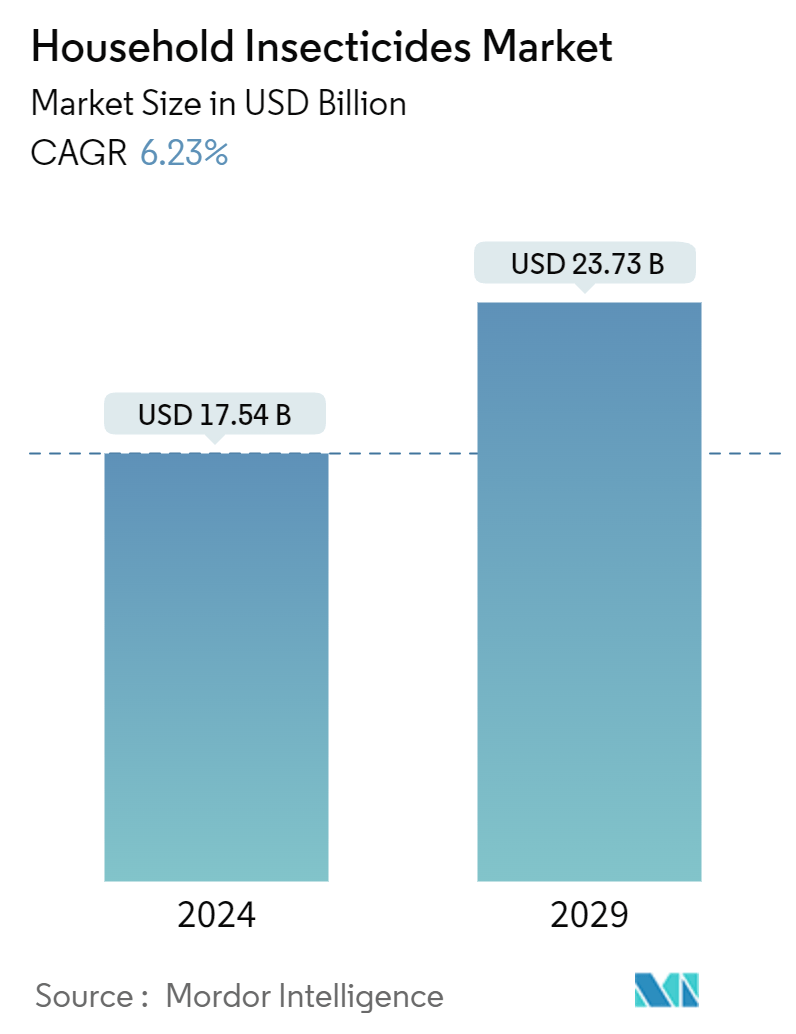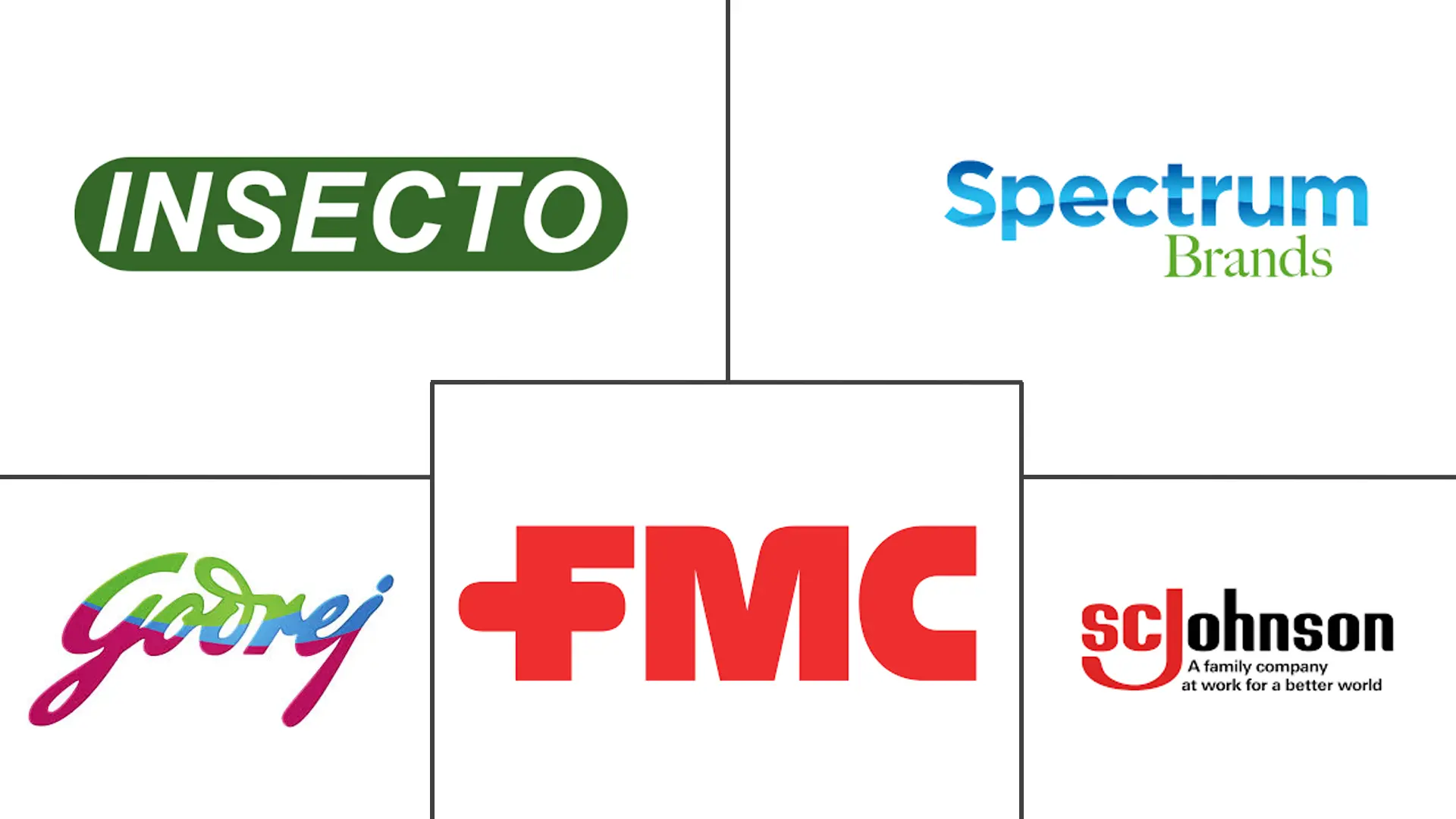Market Size of Household Insecticides Industry

| Study Period | 2019 - 2029 |
| Market Size (2024) | USD 17.54 Billion |
| Market Size (2029) | USD 23.73 Billion |
| CAGR (2024 - 2029) | 6.23 % |
| Fastest Growing Market | Asia Pacific |
| Largest Market | Asia Pacific |
| Market Concentration | High |
Major Players
*Disclaimer: Major Players sorted in no particular order |
Household Insecticides Market Analysis
The Household Insecticides Market size is estimated at USD 17.54 billion in 2024, and is expected to reach USD 23.73 billion by 2029, growing at a CAGR of 6.23% during the forecast period (2024-2029).
- The household insecticides market has grown significantly due to increased awareness of vector-borne diseases and a greater focus on maintaining hygienic living environments. Rising threats from communicable diseases like malaria and increased efforts by local and national government bodies to control insect vectors are expected to drive the market during the forecast period.
- Geographically, Asia-Pacific dominates the market due to the region's large population and tropical climate, which are conducive to insect proliferation. Vector-borne diseases continue to be a significant driver for the household insecticides market. Malaria, the most prevalent vector-borne disease, affected approximately more than 241 million people globally in 2022. Dengue, another mosquito-borne disease, has seen a 30-fold increase in global incidence over the past 50 years, with an estimated 390 million infections occurring annually.
- To cater to the needs of household consumers, companies in the market are increasingly providing convenience through products that are easy to use and require minimal effort. In addition, there is a growing trend toward safer and more environment-friendly household insecticides. For instance, In 2022, SC Johnson introduced a new pest control brand, "STEM," based on natural ingredients and enhanced by scientific research. STEM products use active ingredients derived from plants such as lemongrass, mint, and rosemary oils. The line includes insecticides and repellents that have been tested by entomologists and are scientifically designed to be effective against bugs.
- However, the market faced challenges such as insect resistance and the negative impact of insecticides on the environment and human health. This has led to the development of more effective and longer-lasting insecticides and an increasing demand for sustainable and eco-friendly solutions. As a result, the market is anticipated to grow with a focus on safer and more sustainable products and new innovations aimed at improving effectiveness in controlling insect vectors.
Household Insecticides Industry Segmentation
Home insecticides are products used to kill or control insects within and around the home. They are typically used to control common household pests such as ants, roaches, spiders, and flies. Home insecticides come in various forms, such as sprays, baits, powders, and traps, and are formulated with different active ingredients that target specific types of insects.
The household insecticides market is segmented by insect type into mosquitoes and flies, termites, bedbugs and beetles, and other insect types, by chemical type into synthetic and natural, by form into dust and granules, liquids, aerosol sprays, and other forms, and by geography into North America, Asia-Pacific, Europe, South America, and Africa. The market sizing is provided in value terms (USD) for all the above-mentioned segments.
| Insect Type | |
| Mosquitoes & Flies | |
| Rats & other Rodents | |
| Termites | |
| Bedbugs & Beetles | |
| Other Insect Types |
| Chemical Type | |||||
| |||||
|
| Form | |
| Dust and Granules | |
| Liquids | |
| Aerosol Sprays | |
| Other Forms |
| Geography | |||||||||
| |||||||||
| |||||||||
| |||||||||
| |||||||||
|
Household Insecticides Market Size Summary
The household insecticides market is poised for significant growth, driven by increasing concerns over communicable diseases transmitted by insects, such as malaria and dengue fever. This growth is further fueled by government initiatives aimed at controlling insect vectors and the rising awareness among consumers about the importance of maintaining insect-free households. Companies in the market are responding to these demands by offering products that are easy to use and environmentally friendly, with a notable shift towards synthetic pyrethroids, which are perceived as safer alternatives to traditional insecticides. However, the market faces challenges such as insect resistance and the environmental impact of insecticides, prompting a demand for more sustainable and innovative solutions.
The Asia-Pacific region is a key driver of market expansion due to rapid urbanization, increasing disposable incomes, and a heightened awareness of vector-borne diseases. The region's growing population and urban density have led to a surge in demand for household insecticides as a preventive measure against disease transmission. Governments in this region are actively promoting awareness campaigns and implementing regulations to ensure the safe and effective use of insecticides. The market is characterized by a few major players who dominate the landscape, with companies focusing on product innovation and integrated marketing strategies to enhance their market presence and cater to both urban and rural consumers.
Household Insecticides Market Size - Table of Contents
-
1. MARKET DYNAMICS
-
1.1 Market Overview
-
1.2 Market Drivers
-
1.2.1 Rising Prevalence of Insect-borne Diseases
-
1.2.2 Increased Availability of Household Insecticide Products
-
1.2.3 Urbanization and Population Growth
-
-
1.3 Market Restraints
-
1.3.1 Stringent Government Regulations on the Composition of Insecticide
-
1.3.2 Health and Environmental Concerns
-
-
1.4 Industry Attractiveness - Porter's Five Forces Analysis
-
1.4.1 Bargaining Power of Suppliers
-
1.4.2 Bargaining Power of Buyers
-
1.4.3 Threat of New Entrants
-
1.4.4 Threat of Substitute Products
-
1.4.5 Intensity of Competitive Rivalry
-
-
-
2. MARKET SEGMENTATION
-
2.1 Insect Type
-
2.1.1 Mosquitoes & Flies
-
2.1.2 Rats & other Rodents
-
2.1.3 Termites
-
2.1.4 Bedbugs & Beetles
-
2.1.5 Other Insect Types
-
-
2.2 Chemical Type
-
2.2.1 Synthetic
-
2.2.1.1 N, N-Diethyl-Meta-Toluamide
-
2.2.1.2 Hydroxyethyl Isobutyl Pieridine Carboxylate
-
2.2.1.3 Other Chemical Types
-
-
2.2.2 Natural
-
2.2.2.1 Citronella Oil
-
2.2.2.2 Geraniol Oil
-
2.2.2.3 Other Natural Oils
-
-
-
2.3 Form
-
2.3.1 Dust and Granules
-
2.3.2 Liquids
-
2.3.3 Aerosol Sprays
-
2.3.4 Other Forms
-
-
2.4 Geography
-
2.4.1 North America
-
2.4.1.1 United States
-
2.4.1.2 Canada
-
2.4.1.3 Mexico
-
2.4.1.4 Rest of North America
-
-
2.4.2 Europe
-
2.4.2.1 Germany
-
2.4.2.2 Spain
-
2.4.2.3 United Kingdom
-
2.4.2.4 France
-
2.4.2.5 Italy
-
2.4.2.6 Russia
-
2.4.2.7 Rest of Europe
-
-
2.4.3 Asia-Pacific
-
2.4.3.1 India
-
2.4.3.2 China
-
2.4.3.3 Singapore
-
2.4.3.4 Japan
-
2.4.3.5 Australia
-
2.4.3.6 Rest of the Asia-Pacific
-
-
2.4.4 South America
-
2.4.4.1 Brazil
-
2.4.4.2 Argentina
-
2.4.4.3 Rest of South America
-
-
2.4.5 Africa
-
2.4.5.1 South Africa
-
2.4.5.2 Rest of Souh Africa
-
-
-
Household Insecticides Market Size FAQs
How big is the Household Insecticides Market?
The Household Insecticides Market size is expected to reach USD 17.54 billion in 2024 and grow at a CAGR of 6.23% to reach USD 23.73 billion by 2029.
What is the current Household Insecticides Market size?
In 2024, the Household Insecticides Market size is expected to reach USD 17.54 billion.

